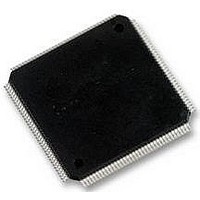M4A5-192/96-10VNC LATTICE SEMICONDUCTOR, M4A5-192/96-10VNC Datasheet - Page 7

M4A5-192/96-10VNC
Manufacturer Part Number
M4A5-192/96-10VNC
Description
MACH4 ISP EEPLD, SMD, TQFP144, 5V
Manufacturer
LATTICE SEMICONDUCTOR
Series
IspMACH 4Ar
Datasheet
1.M4A5-19296-10VNC.pdf
(62 pages)
Specifications of M4A5-192/96-10VNC
No. Of Macrocells
192
No. Of I/o's
96
Propagation Delay
10ns
Frequency
100MHz
Supply Voltage Range
4.75V To 5.25V
Operating Temperature Range
0°C To +70°C
Logic Case
RoHS Compliant
Available stocks
Company
Part Number
Manufacturer
Quantity
Price
Company:
Part Number:
M4A5-192/96-10VNC
Manufacturer:
Lattice
Quantity:
135
Company:
Part Number:
M4A5-192/96-10VNC
Manufacturer:
CITIZEN
Quantity:
7 297
Company:
Part Number:
M4A5-192/96-10VNC
Manufacturer:
Lattice Semiconductor Corporation
Quantity:
10 000
Part Number:
M4A5-192/96-10VNC
Manufacturer:
LATTICE
Quantity:
20 000
Company:
Part Number:
M4A5-192/96-10VNC-12VNI
Manufacturer:
LATTICE
Quantity:
67
Company:
Part Number:
M4A5-192/96-10VNC-12VNI
Manufacturer:
LATTICE
Quantity:
7
Product-Term Array
The product-term array consists of a number of product terms that form the basis of the logic
being implemented. The inputs to the AND gates come from the central switch matrix (Table 5),
and are provided in both true and complement forms for efficient logic implementation.
Logic Allocator
Within the logic allocator, product terms are allocated to macrocells in “product term clusters.”
The availability and distribution of product term clusters are automatically considered by the
software as it fits functions within a PAL block. The size of a product term cluster has been
optimized to provide high utilization of product terms, making complex functions using many
product terms possible. Yet when few product terms are used, there will be a minimal number
of unused—or wasted—product terms left over. The product term clusters available to each
macrocell within a PAL block are shown in Tables 6 and 7.
Each product term cluster is associated with a macrocell. The size of a cluster depends on the
configuration of the associated macrocell. When the macrocell is used in synchronous mode
(Figure 2a), the basic cluster has 4 product terms. When the associated macrocell is used in
asynchronous mode (Figure 2b), the cluster has 2 product terms. Note that if the product term
cluster is routed to a different macrocell, the allocator configuration is not determined by the
mode of the macrocell actually being driven. The configuration is always set by the mode of the
macrocell that the cluster will drive if not routed away, regardless of the actual routing.
In addition, there is an extra product term that can either join the basic cluster to give an
extended cluster, or drive the second input of an exclusive-OR gate in the signal path. If included
with the basic cluster, this provides for up to 20 product terms on a synchronous function that
uses four extended 5-product-term clusters. A similar asynchronous function can have up to 18
product terms.
When the extra product term is used to extend the cluster, the value of the second XOR input
can be programmed as a 0 or a 1, giving polarity control. The possible configurations of the logic
allocator are shown in Figures 3 and 4.
M4A3-32/32 and M4A5-32/32
M4A3-64/32 and M4A5-64/32
M4A3-64/64
M4A3-96/48 and M4A5-96/48
M4A3-128/64 and M4A5-128/64
M4A3-192/96 and M4A5-192/96
M4A3-256/128 and M4A5-256/128
M4A3-256/160 and M4A3-256/192
M4A3-384
M4A3-512
Device
Table 5. PAL Block Inputs
ispMACH 4A Family
Number of Inputs to PAL Block
33
33
33
33
33
34
34
36
36
36
7











